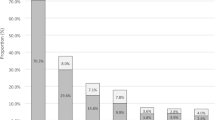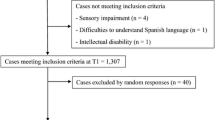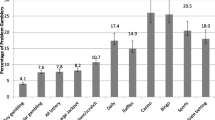Abstract
The opportunity to gamble has undergone rapid expansion with technology allowing for access to gambling products 24 h a day. This increased online availability challenges governments’ abilities to restrict access to gambling. Indeed, the ready access to multiple forms of gambling may potentially contribute to impaired control over urges for problem gamblers. The present study considered whether problem gamblers manifested a tendency to engage in multiple forms of gambling and identified forms of gambling which were more strongly related to problem gambling. In reanalyses of two surveys (Sample 1, N = 464, Sample 2, N = 1141), significant relationships accounting for between 11.3 and 13.5 % of the variance were found between the numbers of forms of gambling accessed and degree of problem. Participation in online poker, playing cards and sports wagering were linked to problem gambling. Access to multiple forms of gambling may pose difficulties for the tracking and control of gambling.
Similar content being viewed by others
References
Abbott, M. (2006). Do EGMs and problem gambling go together like a horse and carriage? Gambling Research, 18(1), 7–38.
Abbott, M. W., & Volberg, R. A. (1991). Gambling and problem gambling in New Zealand. Research Series No 12. Wellington: New Zealand Department of Internal Affairs.
Abbott, M. W., & Volberg, R. A. (1996). The New Zealand national survey of problem and pathological gambling. Journal of Gambling Studies, 12(2), 143–160.
Abbott, M. W., Volberg, R. A., & Ronnberg, S. (2004). Comparing the New Zealand and Swedish national surveys of gambling and problem gambling. Journal of Gambling Studies, 20(3), 237–258.
Broda, A., LaPlante, D., Nelson, S. E., LaBrie, R. A., Bosworth, L. B., & Shaffer, H. J. (2008). Virtual harm reduction efforts for internet gambling: Effects of deposit limits on actual internet sports gambling behavior. Harm Reduction Journal, 5, 27–35.
Clarke, D., Tse, S., Abbott, M., Townsend, S., Kingi, P., & Manaia, W. (2006). Key indicators of the transition from social to problem gambling. International Journal of Mental Health and Addiction, 4, 247–264.
Delfabbro, P. (2008). Evaluating the effectiveness of a limited reduction in electronic gaming machine availability on perceived gambling behaviour and objective expenditure. International Gambling Studies, 8, 151–165.
Doran, B., & Young, M. (2010). Predicting the spatial distribution of gambling vulnerability: An application of gravity modeling using ABS mesh blocks. Applied Geography, 30, 141–152.
Dowling, N., Smith, D., & Thomas, T. (2004). Electronic gaming machines: Are they the ‘crack-cocaine’ of gambling? Addiction, 100, 33–45.
Ferris, J., & Wynne, H. (2001). The Canadian Problem Gambling Index: User manual. Canadian Centre on Substance Abuse. Available at: www.ccsa.ca.
Forster, J. L., Murray, D. M., Wolfson, M., & Wagenaar, A. C. (1995). Commercial availability of alcohol to young people: Results of alcohol purchase attempts. Preventive Medicine, 24, 342–347.
Gainsbury, S., Wood, R., Russell, A., Hing, N., & Blaszczynski, A. (2012). A digital revolution: Comparison of demographic profiles, attitudes and gambling behavior of Internet and non-Internet gamblers. Computers in Human Behavior, 28, 1388–1398.
Griffiths, M., Wardle, H., Orford, J., Sproston, K., & Erens, B. (2008). Socio-demographic correlates of Internet gambling: Findings from the 2007 British Gambling Prevalence Survey. Report prepared for the Gambling Commission. Retrieved Oct 31, 2008, from: www.gamblingcommission.gov.uk/UploadDocs/publications/Document/Internet%20Gambling%20secondary%20analysis.pdf.
Haefeli, J., Lischer, S., & Schwarz, J. (2011). Early detection items and responsible gambling features for online gambling. International Gambling Studies, 11(3), 273–288.
Hoffman, D. L., Novak, T. P., & Peralta, M. (1999). Building consumer trust online. Communications of the ACM, 42(4), 80–85.
Ivanitskaya, L., Brookins-Fisher, J., O’Boyle, I., Vibbert, D., Erofeev, D., & Fulton, L. (2010). Dirt cheap and without prescription: How susceptible are young US consumers to purchasing drugs from rogue Internet pharmacies. Journal of Medical Internet Research, 12(2), e11. doi: 10.2196/jmir.1520.
Johnson, E. J., Moe, W. W., Fader, P. S., Bellman, S., & Lohse, G. L. (2004). On the depth and dynamics of online search behavior. Management Science, 50(3), 299–308.
King, D., Delfabbro, P., & Griffiths, M. (2010). The convergence of gambling and digital media: Implications for gambling in young people. Journal of Gambling Studies, 26, 175–187.
Kruse, H. (2002). Narrowcast technology, interactivity, and the economic relations of space: The case of horse race simulcasting. New Media & Society, 4, 385–404.
LaBrie, R. A., Kaplan, S. A., LaPlante, D. A., Nelson, S. E., & Shaffer, H. J. (2008). Inside the virtual casino: A prospective longitudinal study of actual Internet casino gambling. European Journal of Public Health, 18(4), 410–416.
LaBrie, R. A., LaPlante, D. A., Nelson, S. E., Schumann, A., & Shaffer, H. J. (2007). Assessing the playing field: A prospective longitudinal study of Internet sports gambling behaviour. Journal of Gambling Studies, 23, 347–362.
LaPlante, D. A., Afifi, T. O., & Shaffer, H. J. (2012). Games and gambling involvement among casino patrons. Journal of Gambling Studies. doi: 10.1007/s10899-012-9307-z.
LaPlante, D. A., Nelson, S. E., LaBrie, R. A., & Shaffer, H. J. (2011). Disordered gambling, type of gambling and gambling involvement in the British Gambling Prevalence Survey 2007. The European Journal of Public Health, 21(4), 532–537.
Lesieur, H. R., & Blume, S. B. (1987). The South Oaks Gambling Screen (SOGS): A new instrument for the identification of pathological gamblers. American Journal of Psychiatry, 144, 1184–1188.
Lund, I. (2008). The population mean and the proportion of frequent gamblers: Is the theory of total consumption valid for gambling? Journal of Gambling Studies, 24, 247–256.
Marshall, D. C. (1998). Missing the Jackpot? The proliferation of gambling in Australia and its effect on local communities. Australian Geographical Studies, 36, 237–247.
Marshall, D. C., & Baker, R. G. V. (2002). The evolving market structures of gambling: Case studies modelling the socioeconomic assignment of gaming machines in Melbourne and Sydney, Australia. Journal of Gambling Studies, 18, 273–291.
Martyres, R. F., Clode, D., & Burns, J. M. (2004). Seeking drugs or seeking help? Escalating “doctor shopping” by young heroin users before fatal overdose. Medical Journal of Australia, 180(5), 211–214.
McMillen, J., & Doran, B. (2007). Problem gambling and gaming machine density: Socio-spatial analysis of three Victorian localities. International Gambling Studies, 6, 5–29.
Montaner, M., Lόpez, B., & de la Rosa, J. L. (2003). A taxonomy of recommender agents on the internet. Artificial Intelligence Review, 19, 285–330.
Moore, S. M., Thomas, A. C., Kyrios, M., & Bates, G. (2011). The self regulation of gambling. Journal of Gambling Studies. doi: 10.1007/s10899-011-9265-x. Accessed Feb 16 from http://www.springerlink.com.ezproxy.lib.monash.edu.au/content/m1t223n53p154l48/fulltext.pdf.
Nelson, S. E., LaPlante, D. A., Peller, A. J., Schumann, A., LaBrie, R. A., & Shaffer, H. J. (2008). Real limits in the virtual world: Self-limiting behaviour of Internet gamblers. Journal of Gambling Studies, 24, 463–477.
Nielsen, J. (2000). Designing web usability: The practice of simplicity. Indianapolis: New Riders Publishing.
Nielsen, S., & Barratt, M. J. (2009). Prescription drug misuse: Is technology friend or foe? Drug and Alcohol Review, 28, 81–86.
Parke, J., & Griffiths, M. D. (2007). The role of structural characteristics in gambling. In G. Smith, D. Hodgins, & R. Williams (Eds.), Research and measurement issues in gambling studies (pp. 211–243). New York: Elsevier.
Phillips, J. G., & Blaszczynski, A. (2010). Gambling and the impact of new and emerging technologies and associated products. Report for Gambling Research Australia, Aug 2010.
Phillips, J. G., & Ogeil, R. P. (2011). Decisional styles and risk of problem drinking or gambling. Personality and Individual Differences, 51(4), 521–526.
Phillips, J. G., Ogeil, R. P., & Blaszczynski, A. (in press) Electronic interests and behaviours associated with gambling problems. International Journal of Mental Health & Addiction.
Potenza, M. N., Steinberg, M. A., & Wu, R. (2005). Characteristics of gambling helpline callers with self-reported gambling and alcohol use problems. Journal of Gambling Studies, 21, 233–254.
Productivity Commission (2010). Gambling: Public inquiry. http://www.pc.gov.au/projects/inquiry/gambling-2009. Accessed 9 July 2010.
Riegelsberger, J., Sasse, M. A., & McCarthy, J. D. (2005). The mechanics of trust: A framework for research and design. International Journal of Human Computer Studies, 62, 381–422.
Rigg, K. K., Kurtz, S. P., & Surratt, S. L. (2011). Patterns of prescription medication diversion among drug dealers. Drugs: Education, Prevention and Policy. doi: 10.3109/09687637.2011.631197.
Schafer, J. B., Konstan, J. A., & Riedl, J. (2001). E-commerce recommendation applications. Data Mining and Knowledge Discovery, 5, 115–153.
Schellinck, T. & Schrans, T. (2011). Advances in the use of machine data to identify high risk and problem gamblers: Making it work for casinos worldwide. Paper presented at the 21st annual conference of the National Association for Gambling Studies, 23–25th November, Melbourne.
Shaffer, H. J., LaBrie, R., & LaPlante, D. (2004a). Laying the foundation for quantifying regional exposure to social phenomena: Considering the case of legalized gambling as a public health toxin. Psychology of Addictive Behaviors, 18(1), 40–48.
Shaffer, H. J., LaPlante, D. A., LaBrie, R. A., Kidman, R. C., Donato, A. N., & Stanton, M. V. (2004b). Toward a syndrome model of addiction: Multiple expressions, common etiology. Harvard Review of Psychiatry, 12, 367–374.
Shaffer, H. J., & Martin, R. (2011). Disordered gambling: Etiology, trajectory, and clinical considerations. Annual Review of Clinical Psychology, 7, 483–510.
Shaffer, H. J., Peller, A. J., LaPlante, D. A., Nelson, S. E., & LaBrie, R. A. (2010). Toward a paradigm shift in Internet gambling research: From opinion and self-report to actual behaviour. Addiction Research and Theory, 18(3), 270–283.
Siler, K. (2010). Social and psychological challenges of poker. Journal of Gambling Studies, 26, 401–420.
Wagenaar, A. C., Finnegan, J. R., Wolfson, M., Anstine, P. S., Williams, C. L., & Perry, C. L. (1993). Youth alcohol access: Where and how adolescents obtain alcoholic beverages. Public Health Report, 108, 459–464.
Welte, J. W., Barnes, G. M., Tidwell, M. C., & Hoffman, J. H. (2009). The association of form of gambling with problem gambling among American youth. Psychology of Addictive Behaviors, 23(1), 105–112.
Wood, R., & Williams, R. (2007). Problem gambling on the Internet: Implications for Internet gambling policy in North America. New Media & Society, 9(3), 520–542.
Wood, R., & Williams, R. (2009). Internet gambling: Prevalence, patterns, problems, and policy options. Guelph, Ontario, Canada: Final Report prepared for the Ontario Problem Gambling Research Centre.
Wood, R. T., & Williams, R. J. (2011). A comparative profile of the Internet gambler: Demographic characteristics, game-play patterns, and problem gambling status. New Media & Society, 13, 1123–1141.
Wynne, H. J. (2002). Introducing the Canadian Problem Gambling Index. Edmonton: Wynne Resources.
Acknowledgments
This paper is based in part on a study commissioned by Gambling Research Australia (Tender No 119/06).
Author information
Authors and Affiliations
Corresponding author
Rights and permissions
About this article
Cite this article
Phillips, J.G., Ogeil, R., Chow, YW. et al. Gambling Involvement and Increased Risk of Gambling Problems. J Gambl Stud 29, 601–611 (2013). https://doi.org/10.1007/s10899-012-9325-x
Published:
Issue Date:
DOI: https://doi.org/10.1007/s10899-012-9325-x




